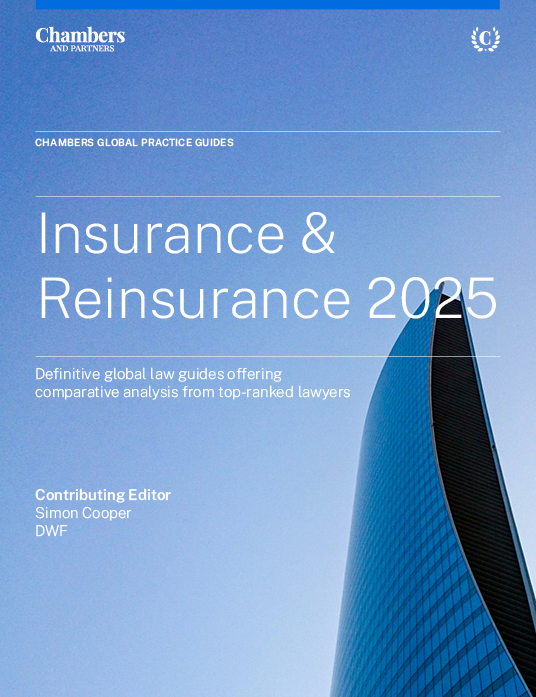
Insurance & Reinsurance 2025
The Insurance & Reinsurance 2025 guide covers close to 30 jurisdictions. The guide provides the latest information on sources of insurance and reinsurance law, overseas-based insurers or reinsurers, making an insurance contract, intermediary involvement, alternative risk transfer (ART) transactions, warranties, conditions precedent, insurance disputes and insurtech.
Last Updated: January 21, 2025
Compare law and practice by selecting locations and topic(s)
Select Locations

Select Topic(s)

Please select at least one location and one topic to use the compare functionality.
A Year Dominated by Geopolitical Conflict, Climate Change and New Technology
The purpose of insurance is to manage risk, but risk evolves constantly. In the last few years, the speed of that evolution has been particularly rapid and has raised many new challenges. How insurers and the law governing insurance respond to these challenges will, inevitably, vary from country to country. This guide not only explains the relevant law in the world’s leading jurisdictions, but also provides the insights of leading lawyers from around the world as to the future developments of risk and law in their countries.
One of the major themes of 2024, and one that will continue into 2025 and beyond, was climate change. The 29th Conference of the Parties (COP29) summit took place in Azerbaijan in November 2024, and its importance for the insurance industry was highlighted by the fact that 2024 was one of the costliest years since 1970 in terms of natural catastrophe losses. Insured losses during the year are estimated at approximately USD1135 billion (according to preliminary results from the Swiss Re Institute for December 2024), stemming from a series of catastrophes ranging from hurricanes to winter storms, flooding and hailstorms. This estimate means that 2024 will be the fifth consecutive year in which insured natural catastrophe losses have exceeded USD100 billion. This, and the fact that 2024 has been the hottest year on record, has only increased the already widespread concern that climate change will cause a long-term increase in the number and severity of natural disasters.
In addition, climate change is likely to challenge previous assumptions about the nature of the risk posed by natural disasters; for example, in 2024 Europe experienced intense flooding, resulting in the second-highest flood losses in the region ever. From a legal perspective, these developments will raise issues of policy construction, for instance in relation to aggregation clauses and the obligation on reinsurers to follow the claims decisions of the underlying insurer. From a regulatory perspective, one may also see steps by governments around the world to compel insurers to provide cover for catastrophic risk. An example of this might be Flood Re in the UK.
The year 2024 was also one of geopolitical instability, with the continuing wars in Ukraine and the Middle East. As well as the horrendous human suffering caused by these conflicts, this instability raises difficult issues for the insurance industry. For example, one of the features of the Western response to Russia’s aggression has been the imposition of sanctions on Russia and its allies, as well as on individuals and organisations associated with Putin’s regime. These sanctions, and the retaliatory sanctions imposed by Russia, create a difficult legal and regulatory environment for insurers, which is further complicated by the different approach to sanction enforcement in different jurisdictions.
In addition to sanctions, the recent instability has emphasised the role of war risk insurance and the scope of the cover that it provides. This has been an issue not only in Ukraine but also with respect to the attacks on shipping in the Red Sea apparently prompted by the conflict in Israel and Gaza. It is unclear whether these attacks are state-backed and how they will be characterised in different jurisdictions for insurance purposes. Indeed, such has been the pressure on this class of business that the main marine insurers have begun to limit the geographical scope of war risk cover in some disputed areas. Furthermore, it has only been possible to write war risk cover in some areas with government backing.
The hybrid nature of modern warfare, including as it does aspects such as cyberconflict as well as physical conflict, brings into question many definitions of “war” in insurance covers. Most cyberpolicies exclude coverage for war and related risk, but defining and proving “war” in the context of a cyber-attack often challenges existing legal definitions, and it is important for insurance buyers as well as insurers to know how different jurisdictions approach this and related issues.
Although the human cost of the COVID-19 pandemic has receded in most parts of the world, the insurance and legal implications of the pandemic continue to be tested. Inevitably, this has led to extensive litigation in several jurisdictions, with the UK and the USA being just two examples. Consequently, courts around the world are revisiting previously accepted approaches to concepts such as causation and aggregation, as well as the proper construction of key policy terms in reinsurance as well as insurance contracts. Clearly, the courts’ conclusions on these issues will vary from jurisdiction to jurisdiction, and this guide provides an invaluable overview to the approaches adopted in key jurisdictions around the world.
Modernising the global insurance industry
In 2024, the drive to modernise the world’s insurance markets continued apace, and that trend will continue in 2025. The changes being introduced are in many cases fundamental and bring with them a range of legal and regulatory challenges for insurers, brokers and regulators alike.
One aspect of the drive for modernisation is the continuing search by established insurers for new markets and territories in which to expand. The desire for expansion is being assisted by regulatory adjustments in some jurisdictions that are increasingly open to external investment, but it is also challenged by the growing assertiveness of insurers domiciled in emerging markets. It is imperative, therefore, that insurers, those in related professions and their advisers all understand the different legal and regulatory requirements for operating in different jurisdictions. This guide, written by experts from around the world, seeks to provide a practical overview of these requirements in the key international jurisdictions.
Insurtech
The growth of insurtech and the wider use of artificial intelligence (AI) presents both opportunities and challenges to insurers and brokers. Insurers are using insurtech to create more personalised and better-targeted insurance products through the development of sophisticated algorithms to analyse detailed source data and broader market data, to produce a highly specific risk profile and price. Similar initiatives are being developed to speed up the handling of claims while increasing insurers’ ability to detect fraud and analyse the cost and benefit of claims disputes. At present, these advances are limited principally to personal lines insurance and SME business, but it is expected that they will be applied to larger commercial risks in the coming years.
The increasing use of insurtech, and AI more generally, brings with it significant legal and regulatory challenges, and the responses are likely to vary from jurisdiction to jurisdiction. For example, insurtech involves managing huge quantities of personal data, which is often of a sensitive nature. The coming into effect of the European Union’s General Data Protection Regulation (GDPR) has created a new legal regime within which insurers have to manage this data, with the risk of incurring very significant financial penalties for non-compliance. Importantly, although this is an EU regulation, it applies to insurers anywhere in the world that hold information about EU citizens, so it has potential ramifications for insurers and their advisers wherever they may be. Jurisdictions outside Europe, of course, have different approaches to data protection, which this guide seeks to highlight.
One of the key objectives of insurtech is to strengthen the connectivity between insurers and their clients. This is achieved through more personalised underwriting and the adoption of different distribution methods, including social media and internet apps. Many innovative new products rely on source data gathered through wearable technology and the internet of things (IoT). These communications, and information from things like wearable technology, will be subject to a new EU regulation, the ePrivacy Regulation (ePR). As with the GDPR, the ePR will have worldwide reach and bring with it the same significant penalties for breach.
All of these technological advances are challenging existing legal assumptions, which are often based on laws developed for an entirely different commercial world. How the laws of different jurisdictions adjust to these challenges is one of the issues this guide seeks to address.
Artificial intelligence
As well as the regulatory issues associated with the growth of insurtech, the adoption of AI technology by insurance buyers raises new legal challenges for insurers, including the question of where liability will lie if a piece of AI technology dependent on machine learning causes injury or breaks the law. Similar issues will arise in relation to the programming of autonomous ships and vehicles and the choices they may have to make when faced with the likelihood of collision. The answer to these questions is likely to differ between jurisdictions, so it will be important for insurers to understand local laws before accepting business that exposes them to risks of this nature.
Political tensions
It is likely that 2025 will see continuing political instability and tensions between some of the world’s leading economies. The insurance industry is not immune to the commercial and regulatory consequences of such conflict. These political tensions have also been expressed in actual or alleged cyber-attacks by one country or its proxy against another. Such attacks can lead to very significant insured losses, both in targeted countries and in other countries that experience “collateral damage”.
Although the Brexit transition period terminated on 1 January 2021, a comprehensive replacement for the previous passporting arrangements has not yet been agreed between the United Kingdom and the remaining EU members. This is one of the many regulatory and legal uncertainties that will continue to hinder UK and European insurers in 2025. Until the post-Brexit regulatory framework has been agreed, bilateral arrangements between the UK and individual EU member states are of an ad hoc nature, and there will inevitably be uncertainty over the ability of UK insurers to write European business (and vice versa) and how that business may be written – for example, with respect to the regulation of underwriting agents.
The emergence of new risks
At the same time, new risks are emerging, and concern continues about the potential for a “new asbestos” – be that legalised cannabis and medical marijuana, opioids, microplastics or nanotechnology. The legal context for the handling of insurance claims and coverage disputes in different jurisdictions will play a large part in determining the impact of any of these risks, if they do emerge.
Despite the uncertainty and risk the industry faces over the coming years, there is no shortage of investment, with private equity houses continuing to show an interest. The industry saw continuing consolidation among insurers and brokers in 2024. In addition, money from outside the industry continues to be invested in new insurance vehicles, such as insurance-linked securities (ILS). Regulators in several jurisdictions are opening their markets to the underwriting of these products, but it remains to be seen whether they can be sufficiently flexible to wrest a meaningful share of the market from Bermuda.
Overall, 2025 is expected to see the continuation and speeding up of the modernisation process across the insurance industry together with a slower, but nonetheless significant, shift towards new markets and new ways of doing business.
